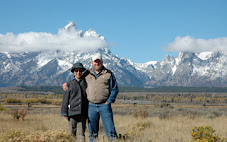I just got a new roof on my Z3 convertible and haven't driven it yet, plus I had the afternoon free, and the weather was beautiful. So I decided it was a good day to take a last ride before I put the car away for the winter.
First, I had to take a picture of the Jensen's beautiful tree.
This is the road through Skull Valley to Dugway (except I took this picture facing north). This is my kind of road. Long and lonely.
I didn't realize the Lincoln Highway came down this road. I had thought it pretty much followed today's I-80 west. It actually came this way to Dugway, followed the Pony Express Trail to Nevada, turned left at today's Highway 93 to Ely, turned right at Highway 50 (The Loneliest Road in America) to Sacramento, and on to San Francisco. Someday Randy and I will need to drive the Lincoln Highway from New York to San Francisco.

Iosepa, which means Joseph for Jospeh F. Smith in Hawaiian, was settle in the late 1800s by Hawaiians and other Polynesian who joined the Church of Jesus Christ of Latter Day Saints and immigrated to Utah to be close to the temple. They originally settle in Salt Lake City, but they were discriminated against by the "white saints." The church tried to find other locations, but they ended up in this desolate spot. They did their best to irrigate and farm, but the town never prospered. When Joseph F. Smith announced a temple in Laie, Hawaii, in 1917, most of the people moved back to Hawaii and Iosepa became a ghost town. Today there's only a cemetery, where people gather each Memorial Day to commemorate the early settlers.
What can I say? This was at a farm house just east of Dugway, which is an army base that no one can enter without military credentials.
Looking down the canyon toward the south end of the Tooele Army Depot.
A view of Mt. Timpanogos from the highway between Vernon and Eureka.
Eureka!
This is the Bullion Beck & Champion Mining Company headframe on the south end of Eureka.






















